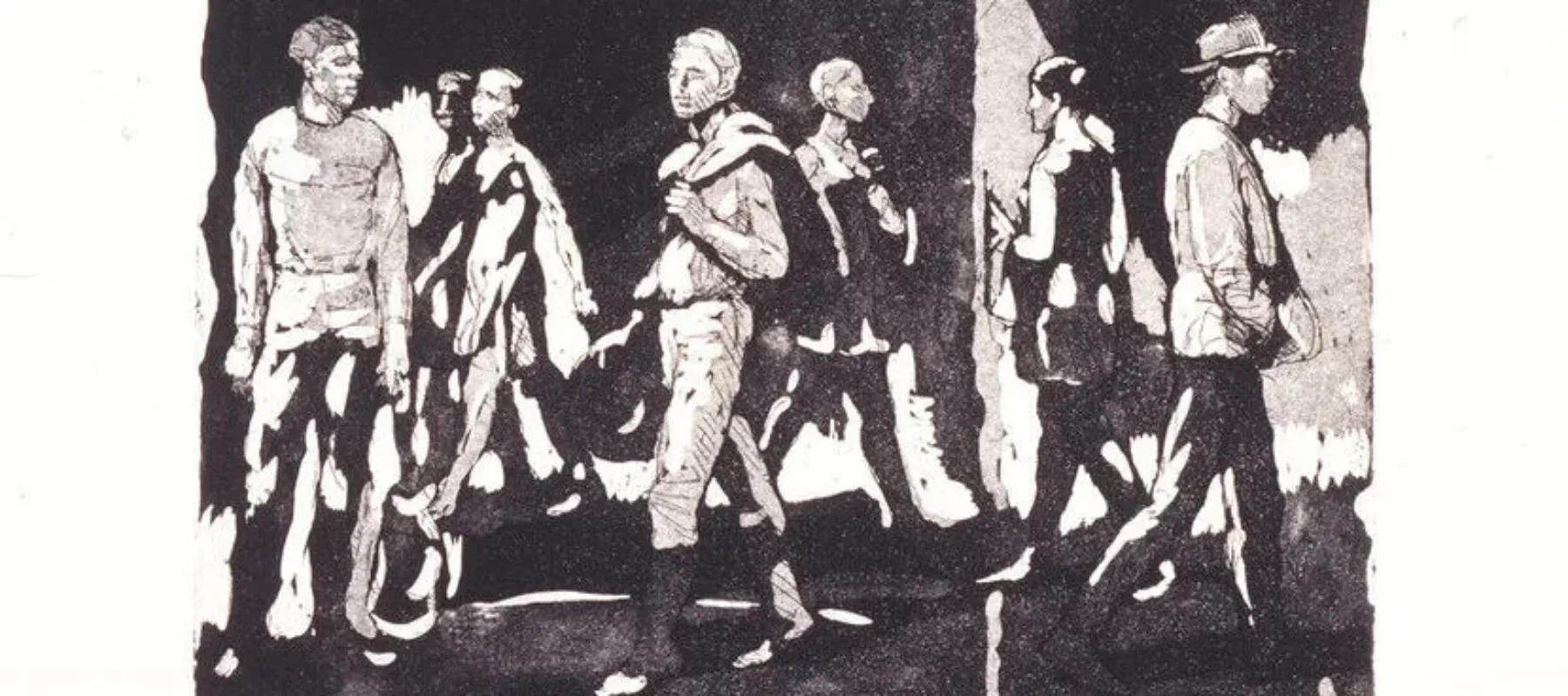WASHINGTON—New York artist Isabel Bishop (1902–1988) devoted her career to depicting the fleeting movements of passersby she observed near her 14th Street studio in Union Square. Inspired by the realism of New York’s Ashcan school as well as by Rembrandt’s depictions of common people, Bishop rejected lofty themes in her art and portrayed her subjects in the middle of candid movements. Organized by the National Museum of Women in the Arts (NMWA) and displayed in the Teresa Lozano Long Gallery, Miracle of Movement: Isabel Bishop in Union Square, New York features 20 works from NMWA’s collection, including 17 prints and paintings generously bequeathed to NMWA in 2004 by Catherine Gamble Curran. Ranging in date from 1927 to 1984, they are studies of the mobility of the human form and daily life in Manhattan.
A painter and printmaker fascinated with the daily routines of ordinary people, Bishop said she was “struck by the beauty, drama, and miraculous effects” of the city’s restless crowds. Born in Cincinnati, Ohio, she arrived in New York City in 1918 at the age of 16. She studied illustration at the New York School of Applied Design for Women from 1918 to 1920 and took classes at the Art Students League from 1920 to 1924. After marrying in 1934, she lived in Riverdale but maintained a studio on Union Square near 14th Street until 1984. A member of New York’s 14th Street School, which comprised realist artists Reginald Marsh, Kenneth Hayes Miller and Raphael Soyer, Bishop is best known for her graphic art, although she also worked as a painter.
It was in New York’s pulsating environment that Bishop combined her admiration for the old masters with a contemporary taste for urban realism. With her discerning eye, she portrayed ordinary people in an extraordinary manner, often monumentalizing her figures within spaces that barely created context or indicated a location. Although it was considered inappropriate for women artists to study naked models, Bishop produced many images of female nudes. She chose average models from the streets of Manhattan and often rendered them in a state of physical activity – a sharp departure from the idealized, passive nudes of previous traditions.
Bishop taught at the Art Students League as the only female full-time instructor from 1936 to 1937, and also at the Skowhegan School of Painting and Sculpture, among others. She received numerous awards and prizes, including an American Academy of Arts and Letters award (1943), an award for Outstanding Achievement in the Arts presented by President Jimmy Carter (1979), and several honorary doctorates. She was the first woman to hold an executive position in the National Institute of Arts and Letters as vice-president in 1946.
Miracle of Movement: Isabel Bishop in Union Square, New York will be on display through May 17, 2009. The exhibition is made possible by the generous donation of works from Catherine Gamble Curran, Helen T. Matthews and Carol and Walter Ceglowski.
It was in New York’s pulsating environment that Bishop combined her admiration for the old masters with a contemporary taste for urban realism. With her discerning eye, she portrayed ordinary people in an extraordinary manner, often monumentalizing her figures within spaces that barely created context or indicated a location. Although it was considered inappropriate for women artists to study naked models, Bishop produced many images of female nudes. She chose average models from the streets of Manhattan and often rendered them in a state of physical activity – a sharp departure from the idealized, passive nudes of previous traditions.
Bishop taught at the Art Students League as the only female full-time instructor from 1936 to 1937, and also at the Skowhegan School of Painting and Sculpture, among others. She received numerous awards and prizes, including an American Academy of Arts and Letters award (1943), an award for Outstanding Achievement in the Arts presented by President Jimmy Carter (1979), and several honorary doctorates. She was the first woman to hold an executive position in the National Institute of Arts and Letters as vice-president in 1946.
Miracle of Movement: Isabel Bishop in Union Square, New York will be on display through May 17, 2009. The exhibition is made possible by the generous donation of works from Catherine Gamble Curran, Helen T. Matthews and Carol and Walter Ceglowski.
###
National Museum of Women in the Arts
The National Museum of Women in the Arts (NMWA), founded in 1981 and opened in 1987, is the only museum solely dedicated to celebrating the achievements of women in the visual, performing and literary arts. The museum’s permanent collection features 3,000 works from the 16th century to the present created by more than 800 artists; including Mary Cassatt, Frida Kahlo, Alma Thomas, Lee Krasner, Louise Bourgeois, Chakaia Booker along with special collections of 18th-century silver tableware and botanical prints. The museum also conducts multidisciplinary programs for diverse audiences and maintains a Library and Research Center which is accessible to the public. NMWA is located at 1250 New York Avenue, NW, Washington, D.C., in a landmark building near the White House. It is open Monday–Saturday, 10 a.m.–5 p.m. and Sunday, noon–5 p.m. For information, call 202-783-5000 or visit the museum’s Web site at www.nmwa.org.

